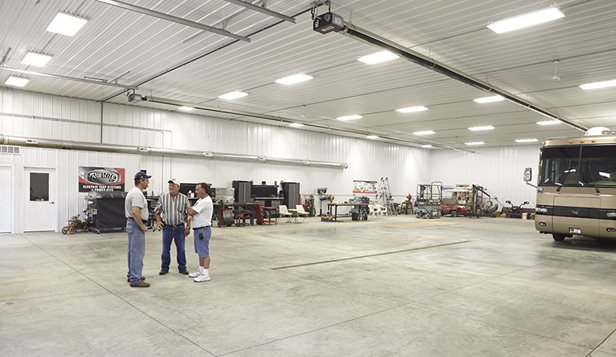If you’ve already built or are planning to build a Lester Building, you’ve made an excellent choice! Lester’s engineered wood frame structures rank highly in terms of durability and design flexibility. They will last for decades and with a little maintenance, they will remain in tip-top shape.
Pole barns require less maintenance than other types of buildings because of the materials used. Since the early 1990s, advancements in protective treatments have made wooden posts more rot-resistant. The paint and coatings used to protect steel panels used on the exterior of the building have also been improved over the years. Those factors mean the typical pole barn can remain standing and in good condition for decades regardless of heavy-duty use or harsh weather.
“There’s no reason why your building shouldn’t last your lifetime,” notes Craig Loger, Vice President of Sales for Lester Buildings. “We have many built in the ’60s and ’70s that are still performing the same as they did back then.”
While the design of pole barns often makes them among the most weather-resistant structures available, any kind of construction shows wear over time.

Consider these maintenance tips for keeping your post-frame Lester Building looking great and in superior shape through the years.
1. Review Your Roof
Climbing up on the roof isn’t necessary. Quarterly, identify potential trouble spots by inspecting your ceiling inside for leaks. That’s often easier during rainstorms, when sources of moisture are instantly identifiable. If a leak is identified, call a professional contractor to make repairs needed to avoid any deterioration to your building.
2. Remove Debris
Following storms, you should ensure your gutters are free of debris and your roof is free of fallen branches that could end up damaging your roof. In the winter, you should check gutters for ice dams and use a roof rake to push off excess snow that could cause a roof collapse.
3. Clean with Care
Once a year you may wish to power wash the exterior of your pole barn, taking care to stay a safe distance away so the spray doesn’t void warranties by causing dents or removing paint. In between, you can simply use a hose to rinse off mud or debris, says Loger.
4. Ponder Painting
Loger notes that painted steel is typically warrantied against chalking and fading for 30 to 40 years, depending on when it was built. If you do you wish to refresh the paint on your pole barn, however, Loger recommends hiring a professional contractor experienced in steel surfaces.
5. Landscape Strategically
Loger advises grading exterior soil four-to-six inches lower than your building floor to discourage water accumulation and the threat of deterioration. “If you add two feet of rock, when water runs off your roof the dirt won’t splash against the side,” he notes. He recommends taking care when mowing grass around your building, since projected rocks or debris could dent your metal siding. He also warns about spraying weed killer and other chemicals near the building, which may void the paint warranty.
6. Deter Deterioration
At Lester, structural lumber for columns that contact the ground are treated against fungal decay and termite infestation and are warrantied for 50 years. But posts used by some builders prior to 1991 could be more vulnerable. “Treated wood is formulated to actually kill (burrowing) insects,” Loger notes. “As long as your pole barn is built properly, they shouldn’t be a problem. But there’s never anything wrong with checking for flying ants, termites or other kinds of bugs that like wood — and if you see them, you should find a good exterminator.” The most vulnerable spots on a pole are six inches above and below the soil where oxygen and moisture most interact, he says.
7. Think About Moisture
Condensation inside your building can be a sign of insufficient airflow that could eventually lead to corrosion. If you see it, you may wish to consult with an HVAC specialist who can identify the problem. “It’s no different than in your home,” Loger notes. “Air barriers and vapor barriers need to be installed in proper locations.” Ensuring proper ventilation is particularly crucial if your building houses concentrated numbers of animals; their manure and the moisture they generate could affect their health if not adequately addressed.
8. Dodge Drafts
Post-frame buildings typically provide superior insulation because of thicker wall cavities and wide spans between posts. If you detect drafts, check to see if your vapor or air barriers have been properly sealed.
9. Scan Weather Stripping
Check seals to make sure doors and windows are still closing snugly, keeping out precipitation and conserving energy.
While some maintenance of your pole barn may be necessary through the years, you should find that maintenance far less time-consuming than the care required for more traditional construction. That may make a post-frame building the ideal choice for your next shelter.
Have additional questions about the pros and cons of constructing a post-frame building? Talk to the experienced professionals at Lester Buildings for answers.
